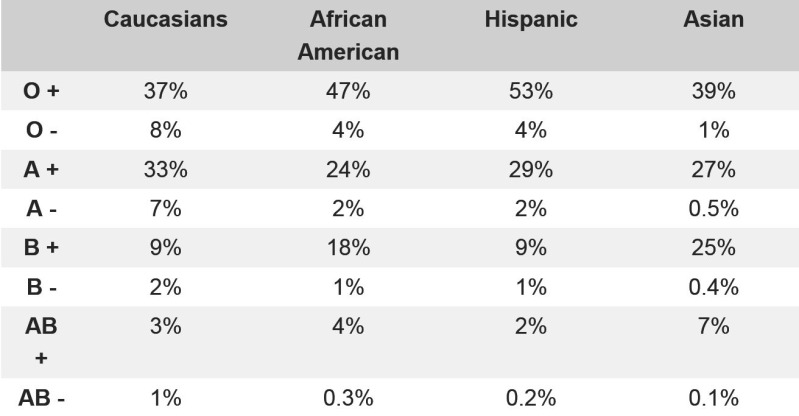What is the Rarest Blood Type
The rarest blood type is actually Rh-null, which is the lack of antigens in the Rh system. Less than 1 in 1,000 people have this blood type.
However, individuals of this type can donate blood to just about every blood type.
Before we proceed to understanding more about Rh-null being the most rare blood type along with various reasons for its occurrence, let us first also consider to have a look and create a good background about the rarity rate of ABO blood types:
ABO Blood Type Rarity Chart

Now, what is the most rare blood type in the group?
As can be clearly seen above, among the ABO blood group, AB- is the least common blood type.
Rare blood types can be a problem. When a person has a rare blood type and needs blood transfusion, it is extremely difficult for him to obtain blood donations compatible with his system.
The Rarest Blood Type
1. Environmental conditions
Several among rare blood types are more prevalent in specific parts of the world where they manifest.
Duffy-negative blood is unique to people of African origin while Rh-null blood occurs more in people living around East Asia.
This may be due to environmental conditions of the region.
For example, if you perform a research on identifying what blood type is rare in East Asia, you may find it to be different from one place to another.
2. Family Genetics
The Rh-null blood type is inherited and has been known to run in families.
Children inherit the rare condition from their parents or other people in their lineage. This makes it almost impossible for other people to develop it without a family history of the blood type.
It develops when individuals inherit a suppressor gene unrelated to the RH locus or a silent allele at the locus itself.
3. Mutations
The Rh-null blood type can also be brought about by genetic mutations.
The genetic composition of blood cells could change over time, giving rise to Rh- blood.
4. Fragility of Red Blood Cells
Patients who suffer from the Rh-null phenomenon are said to suffer from the Rh-null syndrome.
People with this syndrome are known to have osmotically fragile Red Blood Cells, called stomatocytes.
These patients exhibit subsequent chronic haemolytic anaemia, whose degree varies from patient to patient.
5. Molecular Change in RHCE gene, with a deleted RHD gene
There is an amorph type of the condition, which is brought about by at least two different genetic mechanisms, particularly a molecular change in the RHCE gene, with a deleted RHD gene.
6. A defect in the RHAG Gene
There is also a regulator’ type of the Rh- null phenomenon.
The defect in the RHAG gene leads to the Rh-null condition.
These patients experience chronic haemolysis, with varying severity and characterized by stomatocytosis, spherocytosis, defective cation fluxes and other conditions.
7. Lack of or severe reduction of Rh blood group antigens
The Rh-null blood type predominantly arises due to lack of Rh blood group antigens, or when the Rh antigens decrease severely.
Blood from these patients does not react with antiseras.
R-null cells lack Rh polypeptides and are deficient in Rh-associated glycoprotein and glycophorin.
8. Abnormal Red Cell Morphology
The person’s Red Blood Cells may have a form or structure that is not common or usual.
This may cause the person’s blood cells to behave differently than normal ones would, leading to various conditions, like the Rh-null condition.
9. Hybrid Genes
An RHD hybrid gene contains nucleotide sequences from the RHCE gene.
It produces no D antigen and abnormal C antigen, leading to Rh-null blood.
An Rh-null condition brought about in this manner can also be passed down from parents to offsprings.
10. Uncommon Rh phenotypes
The D antigen contains over 30 epitopes.
When these epitopes are missing or are weakly expressed, it leads to the Rh-null complication.
- READ MORE





What does it mean when the blood bank categorizes your blood as “rare – no red blood cell antigens”?
I have o null and have nearly died a few times when injured. There was no blood available.